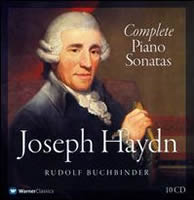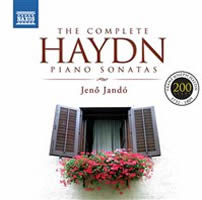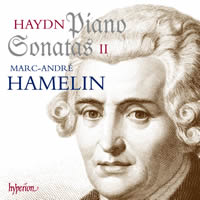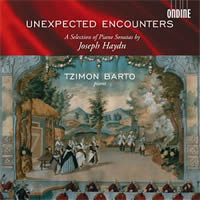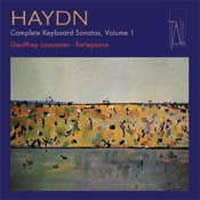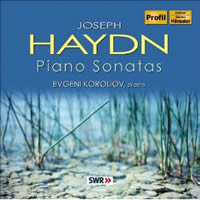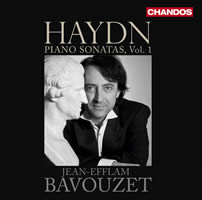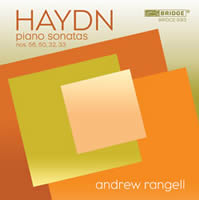Piano Factory 5: Haydn Sonatas
|
Grant Chu Covell [May 2010.] After exploring Schubert’s sonatas on fortepiano, I thought I’d similarly prefer Haydn’s sonatas on period instruments. Not so. Perhaps I find a modern instrument more to my taste owing to my middling success traipsing through Papa’s sonatas. Then again, Haydn’s lighter textures avoid Schubert’s typical doublings. So while I prefer Schubert on fortepiano, I don’t mind Haydn on a modern keyboard. Would you fault me for inconsistency? Well, don’t say I wasn’t up-front about it. Coming off a Haydn year (2009), we’re awash in the man’s music. The piano sonatas are numbered according to Christa Landon’s ordering of the extant 62. The parenthetical numbering refers to Anthony van Hoboken’s catalog of Haydn’s works in which piano sonatas are category 16.
Joseph HAYDN: Complete Piano Sonatas. Rudolph Buchbinder (pno). Warner Classics 256463782-2 (10 CDs) (http://www.warnerclassics.com/). The Complete HAYDN Piano Sonatas. Jenő Jandó (pno). Naxos 8.501042 (10 CDs) (http://www.naxos.com/). HAYDN – Complete Music for Solo Keyboard. Ronald Brautigam (fortepiano). BIS-CD-1731/33 (15 CDs) (http://www.bis.se/). Distributed in the US by Qualiton (http://www.qualiton.com/). Joseph HAYDN: Piano Sonatas II. Marc-André Hamelin (pno). Hyperion CDA67710 (2 CDs) (http://www.hyperion-records.co.uk/). Distributed in the US by Harmonia Mundi (http://www.harmoniamundi.com/). Haydn’s technical requirements offer professionals no difficulties. The challenges reside in taste and expression. I want to admire the pianist’s understanding of Haydn’s wit. I want to be charmed. I look for delicate quickening and subtle restraint at unexpected harmonies. Ornaments should be light. Melodic lines should be expressive cantilenas. Looking first at the complete and multi-disc sets, I picked Sonata No. 59 in E-flat major (XVI: 49), the “Genzinger” of 1789-90 when the composer was around 60. The first edition indicated the sonata was written for Anna Jerlischek even though Marianne von Genzinger was the dedicatee. Madame Genzinger was the wife of Prince Esterházy’s physician and a frequent Haydn correspondent. Jerlischek (also spelled Gerlischek) was a maid at Esterházy’s palace who married Johann Tost, a violinist in the prince’s orchestra. Buchbinder’s set was recorded over several sessions, from 1973 to 1975. Spanning ten discs, it’s basic and functional. These analogue recordings suffer from a narrow spectrum and minimal resonance. Jandó’s 1992 recording is vibrant. No. 59 opens a disc with the last three “London” sonatas, Nos. 60-62 (XVI: 50-52). It’s impossible to ignore the gusto Jandó brings to No. 60 (XVI: 50). Jandó was criticized for having recorded nearly everything written on two staves for Naxos’ early days. Perhaps so, but his Haydn warrants serious consideration. Performing on a fortepiano which offers limited responsiveness compared to a modern instrument, Brautigam quickly delineates the extremes from thundering octaves to delicate tracery. Overall, Brautigam’s 1998 recording provides immense variety. BIS offers the collection of 15 discs at the price of 3, an astounding bargain. Hamelin provides panache and scant subtlety. His Haydn lacks snap. Referring back to his first Haydn double set (Hyperion CDA67554), a technically fine No. 60 lacks charm. While Hamelin’s virtuosic ease is well employed elsewhere, his cool Haydn becomes wallpaper. Haydn: Piano Sonata No. 59 in E-flat major (XVI: 49) (1789-90)
Joseph HAYDN: Sonata No. 10 in C major (XVI: 1); Sonata No. 38 in F major (XVI: 23); Sonata No. 42 in G major (XVI: 27); Sonata No. 60 in C major (XVI: 50). Tzimon Barto (pno). Ondine ODE 1154-2 (http://www.ondine.net/). “Complete Keyboard Sonatas, Vol. 1.” Joseph HAYDN: Sonata No. 32 in G minor (XVI: 44); Sonata No. 31 in A-flat major (XVI: 46); Sonata No. 33 in C minor (XVI: 20). Geoffrey Lancaster (fortepiano). Tall Poppies TP201 (http://www.tallpoppies.net/). Joseph HAYDN: Sonata No. 48 in C Major (XVI: 35); Sonata No. 32 in G minor (XVI: 44); Sonata No. 53 in E minor (XVI: 34); Sonata No. 58 in C major (XVI: 48); Sonata No. 62 in E-flat major (XVI: 52); Sonata in E-flat major (not in Hoboken catalog). Evgeni Koroliov (pno). Profil PH10002 (http://www.haensslerprofil.de/). “Piano Sonatas, Volume 1.” Joseph HAYDN: Sonata No. 39 in D major (XVI: 24); Sonata No. 47 in B minor (XVI: 32); Sonata No. 31 in A-flat major (XVI: 46); Sonata No. 49 in C-sharp minor (XVI: 36). Jean-Efflam Bavouzet (pno). Chandos CHAN 10586 (http://www.chandos.net/). Distributed in the US by Naxos (http://www.naxos.com/). Joseph HAYDN: Sonata No. 56 in D major (XVI: 42); Sonata No. 50 in D major (XVI: 37); Sonata No. 32 in G minor (XVI: 44); Sonata No. 33 in C minor (XVI: 20). Andrew Rangell (pno). Bridge 9313 (http://www.bridgerecords.com/). No doubt about it, Haydn invites cheekiness and Barto provides it — exaggerated accents, extreme dynamics and fluctuating tempos in No. 60. If a student played this way, we’d call it misguided. When Barto does it, we call it artistry. Sonatas 10 and 38 sound as if Barto has set out to pack his performance with as much expression as possible. This approach isn’t right elsewhere and is just barely acceptable here. Lancaster’s instrument is a 2008 Paul McNulty, a copy of a 1788 Johann Andreas Stein. Lancaster prefaces each sonata with a short prelude, really more like a flourish, in order to establish the key. Some were improvised on the spot, others derived from contemporaneous preludes by Clementi and others. The booklet is well-detailed, as are these readings. Koroliov’s remote acoustic and prosaic Romantic touch do Haydn no favors. Koroliov is commendably fleet, yet lacking in impishness. The finale to No. 53 demands more humor. No. 62, played expansively, leans more into the 19th century than do the other sonatas. Bavouzet produces classic elegance, balancing restraint with expressive artistry. Probably the most suave Haydn in this batch, and nicely recorded too. If you’re looking for slightly rougher edges and a more modern personality, then you’ll want to spend time with Rangell for Haydn via present-day expressiveness. Haydn’s keyboard oeuvre has not invaded the popular imagination in quite the same way as have the piano works of Mozart, Beethoven and Schubert. Similarly, few composers appear to revere Haydn, with exceptions. Haydn need not be performed as if on a parlor spinet; conversely, we need not belabor the music with rubato and heavy pedaling. Perhaps most significantly, players miss the point when they diminish Haydn’s levity.
[More Grant Chu Covell, Piano Factory]
[More
Haydn]
[Previous Article:
The Enchanted Kielbasa]
[Next Article:
Biber on Symphonia]
|
